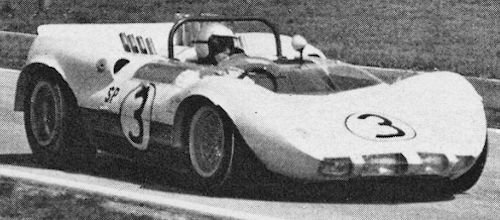Chaparral race cars
Automotive race car manufacturer of USA From 1963 to 1970.

Chaparral was a racing car project of Texas racing driver and designer Jim Hall , which existed from 1963 to 1970 .
History
The technically revolutionary vehicles were characterized among others by the first successful use of automatic transmissions (2D, 1966), and huge rear wings (2E, 1966 and 2F, 1967) and the first "vacuum cleaner racing car" (2J, 1970). In this regard, they were pioneers of many other constructions. The Formula 1 took over the rear wing a year later; Brabham copied the "vacuum cleaner" with the Brabham BT46B .
The Chaparral prototypes won some races or fastest lap times in the United States. Powered by Chevrolet V8 engines . A technical highlight was the type 2J of 1970, which also had a two-stroke engine and side skirts. This ILO - snowmobile engine driving two 17-inch fanwith a constant speed of 5000 / min, which sucked the air under the car and provided for an increased contact pressure . The additional contact pressure is given as 900 pounds (4 kN ).
The cars were less known to the European public by the victory of Phil Hill / Joakim Bonnier in 1966 at the Nürburgring than by the numerous miniature models of these racing cars, which were found in every toy store in the late 1960s and early 1970s.
The Chaparral models were named for years with 2 (1963), 2C (1965), 2D (1966), 2E (1966), 2F (1967), 2G (1968), 2H (1969) and 2J (1970).
Technical
-
Chaparral race cars Technical data
Chaparral:
1966 (2D)
1967 (2F)
Engine:
V8 cylinder, 90 °
displacement:
5354 cc (327 ci )
6996 cc (427 ci)
Bore × stroke:
101.6 × 82.55 mm
107.98 × 95.5 mm
Power:
316 kW (430 hp)
405 kW (550 hp)
at 1 / min:
6800
6500
Compression:
11.0: 1
11.0: 1
Transmission:
2-speed automatic
3-speed automatic
Wheelbase:
2340 mm
2380 mm
Wheel size:
9 / 12-15
6.50 / 7-15
Dry weight:
780 kg
830 kg
